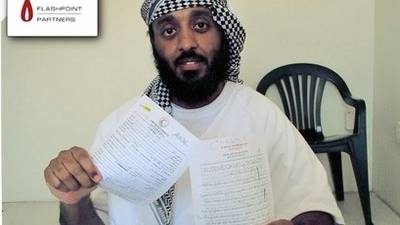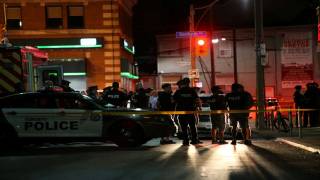Terrorist Interrogation Tapes found under CIA desk
Source: news.yahoo.com
The CIA has videotapes, after all, of interrogations in a secret overseas prison of admitted 9/11 plotter Ramzi Binalshibh.Discovered in a box under a desk at the CIA, the tapes could reveal how foreign governments aided the United States in holding and interrogating suspects. And they could complicate U.S. efforts to prosecute Binalshibh, who has been described as one of the "key plot facilitators" in the Sept. 11, 2001, attacks.

Ramzi Binalshibh is shown. Binalshibh is being held pending trial at a U.S. military facility in Guantanamo Bay, Cuba. (AP Photo/Flashpoint Partners)
Apparently the tapes do not show harsh treatment — unlike videos the agency destroyed of the questioning of other suspected terrorists.
The two videotapes and one audiotape are believed to be the only existing recordings made within the clandestine prison system and could offer a revealing glimpse into a four-year global odyssey that ranged from Pakistan to Romania to Guantanamo Bay.
The tapes depict Binalshibh’s interrogation sessions in 2002 at a Moroccan-run facility the CIA used near Rabat, several current and former U.S. officials told The Associated Press. They spoke on the condition of anonymity because the videos remain a closely guarded secret.
Al Qaeda Interrogation Tapes Found in CIA (Video)
When the CIA destroyed its cache of 92 videos of two other al-Qaida operatives, Abu Zubaydah and Abd al-Nashiri, being waterboarded in 2005, officials believed they had wiped away all of the agency’s interrogation footage. But in 2007, a staff member discovered a box tucked under a desk in the CIA’s Counterterrorism Center and pulled out the Binalshibh tapes.
If the tapes surfaced at Binalshibh’s trial, they could highlight Morocco’s role in a counterterrorism program known as Greystone, which authorized the CIA to hold terrorists in secret prisons and shuttle them to other countries.
The American Civil Liberties Union has asked the government to provide more information about the tapes as part of a long-running lawsuit involving the treatment of detainees.
"Today’s report is a stark reminder of how much information the government is still withholding about the Bush administration’s interrogation policies," said Alexander Abdo, staff attorney with the ACLU National Security Project.
More significantly to the 38-year-old terror suspect’s defense, the tapes also could provide evidence of Binalshibh’s mental state within the first months of his capture. In court documents, defense lawyers have been asking for medical records to see whether his years in CIA custody made him mentally unstable. He is being treated for schizophrenia with a potent cocktail of anti-psychotic medications.
With military trial commissions on hold while the Obama administration figures out what to do with a number of terror suspects, Binalshibh has never had a hearing on whether he is mentally fit to stand trial.
"If those tapes exist, they would be extremely relevant," said Thomas A. Durkin, Binalshibh’s civilian lawyer.
A Justice Department prosecutor who is already investigating whether destroying the Zubaydah and al-Nashiri tapes was illegal is now also looking into why the Binalshibh tapes were not disclosed.
The CIA first publicly hinted at the existence of the tapes in 2007 in a letter to U.S. District Judge Leonie M. Brinkema in Virginia. The government twice denied having such tapes, recanting once they were discovered. But the government blacked out Binalshibh’s name from a public copy of the letter.
At the time, the CIA played down the significance of the videos, saying they were not taken as part of the agency’s detention program and did not show CIA interrogations.
But that case can be made only because of the unusual nature of the Moroccan prison, which was largely financed by the CIA but run by Moroccans, the former officials said. The CIA could move detainees in and out, and oversee the interrogations, but officially Morocco had control.
Moroccan government officials did not respond to queries seeking comment on Binalshibh and his time in Morocco. The country has never acknowledged the existence of the detention center.
Morocco has a history of prison abuse and human rights violations. A Moroccan-created commission identified decades of torture, forced disappearances, poor prison conditions and sexual violence. This year’s U.S. State Department report on Morocco notes continued accusations of torture by security forces.
Still, current and former officials say no harsh interrogation methods, like the simulated drowning tactic called waterboarding, were used in Morocco. In the CIA’s secret network of undisclosed "black prisons," Morocco was described as a way station to hold detainees for a few months at a time.
"The tapes record a guy sitting in a room just answering questions," according to a U.S. official familiar with the program. "They don’t show any harsh treatment."
That would make them quite different from the 92 interrogation videos of Zubaydah and al-Nashiri being subjected to waterboarding and other harsh interrogation tactics.
The tapes provide just a snapshot of Binalshibh’s journey through CIA black prisons. He was bounced from one undisclosed facility to the next and his story, if it ever comes out at trial, could reveal new details about the CIA prison network. Defense attorneys have described this journey as "a blot on this nation’s character."
Intelligence officials maintain the tough tactics saved many lives.
CIA spokesman George Little said: "While we continue to cooperate with inquiries into past counterterrorism practices, the CIA’s focus now is exactly where it should be: protecting the American people now and into the future."
Read the full article at: news.yahoo.com






















